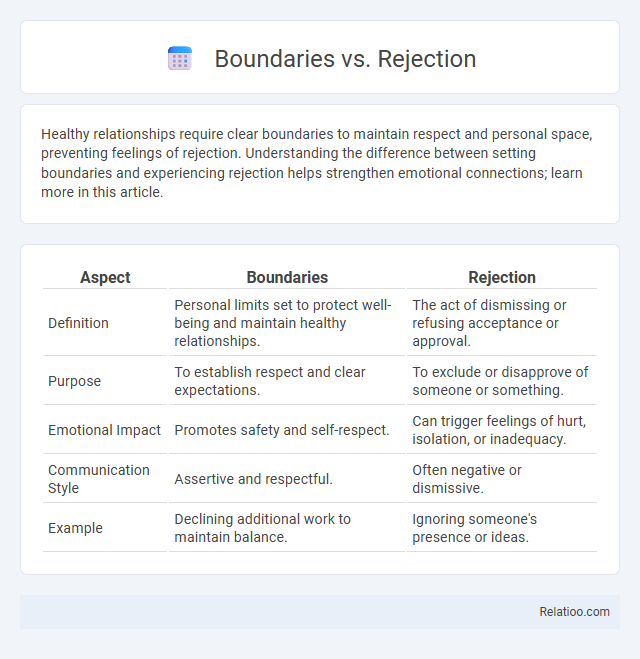Healthy relationships require clear boundaries to maintain respect and personal space, preventing feelings of rejection. Understanding the difference between setting boundaries and experiencing rejection helps strengthen emotional connections; learn more in this article.
Table of Comparison
| Aspect | Boundaries | Rejection |
|---|---|---|
| Definition | Personal limits set to protect well-being and maintain healthy relationships. | The act of dismissing or refusing acceptance or approval. |
| Purpose | To establish respect and clear expectations. | To exclude or disapprove of someone or something. |
| Emotional Impact | Promotes safety and self-respect. | Can trigger feelings of hurt, isolation, or inadequacy. |
| Communication Style | Assertive and respectful. | Often negative or dismissive. |
| Example | Declining additional work to maintain balance. | Ignoring someone's presence or ideas. |
Understanding Boundaries: Definition and Purpose
Boundaries define your personal limits to protect emotional safety and foster healthy relationships by clearly communicating what is acceptable and what is not. They serve as a preventive measure against rejection by promoting respect and understanding between individuals. Understanding boundaries empowers you to maintain emotional well-being while navigating social interactions with confidence and clarity.
What Is Rejection? Key Differences from Boundaries
Rejection occurs when someone explicitly denies or refuses your request, presence, or feelings, often leading to emotional pain or vulnerability, whereas boundaries are self-imposed limits that protect your emotional and physical well-being. Understanding the key differences between rejection and boundaries helps you distinguish external dismissal from your personal right to set limits, fostering better emotional safety. While rejection can feel like a personal attack, setting boundaries empowers you to maintain respect and preserve your mental health.
Setting Healthy Boundaries: Signs and Strategies
Setting healthy boundaries involves clearly defining personal limits to protect emotional safety and prevent feelings of rejection. Key signs include discomfort when others overstep, resentment, or emotional exhaustion, signaling the need to communicate limits assertively. Effective strategies encompass self-awareness, consistent communication, and prioritizing self-care to maintain respectful and safe interactions.
The Emotional Impact of Rejection vs. Boundaries
Rejection often triggers feelings of inadequacy and emotional pain, eroding one's self-esteem and trust in relationships, whereas setting boundaries fosters emotional safety by clearly defining limits to protect personal well-being. Unlike rejection, which is typically perceived as a personal dismissal, boundaries promote respect and understanding, reducing anxiety and preventing emotional burnout. Establishing healthy boundaries serves as a proactive mechanism for maintaining emotional resilience and preventing the negative psychological effects commonly associated with rejection.
Communication Skills: Expressing Boundaries Without Rejecting
Mastering communication skills allows you to express boundaries clearly while avoiding feelings of rejection, fostering emotional safety in relationships. Using "I" statements and focusing on your feelings helps communicate limits respectfully, ensuring your needs are understood without alienating others. This approach enhances trust and maintains connection, promoting healthy emotional exchanges.
Common Misconceptions About Boundaries and Rejection
Many people confuse setting boundaries with rejecting others, but boundaries are healthy limits that protect your emotional safety rather than a refusal to connect. Rejection often feels personal, yet boundaries are decisions centered on your well-being and maintaining respectful relationships. Understanding this distinction helps you communicate needs clearly without fearing emotional harm.
Respecting Others: Navigating Boundary Setting with Empathy
Respecting others involves understanding the difference between boundaries, rejection, and emotional safety to foster empathy in relationships. Boundaries define personal limits and communicate needs clearly, while rejection can feel dismissive but is not always about disrespect. Prioritizing emotional safety ensures that setting boundaries is done with kindness, allowing others to feel valued rather than shut out.
Self-Worth: How Boundaries and Rejection Affect Self-Esteem
Healthy boundaries protect self-worth by defining limits that prevent emotional harm, fostering a sense of respect and personal value. Rejection can challenge self-esteem by triggering feelings of inadequacy, yet strong boundaries help individuals differentiate between others' opinions and intrinsic self-worth. Prioritizing emotional safety through clear boundaries reinforces resilience, ensuring that rejection does not erode one's self-esteem but instead supports personal growth.
Healing After Rejection vs. Adjusting to Boundaries
Healing after rejection involves processing emotional pain and rebuilding self-worth to restore inner balance, while adjusting to boundaries requires recognizing and respecting limits set by oneself or others to foster healthy relationships. Emotional safety is established when individuals feel secure expressing feelings without fear of rejection or boundary violations, promoting trust and psychological well-being. Effective healing combines self-compassion with understanding personal and interpersonal boundaries, enabling recovery and growth in emotional resilience.
Building Stronger Relationships Through Healthy Boundaries
Establishing healthy boundaries promotes emotional safety by clearly defining acceptable behaviors and limits, reducing misunderstandings and feelings of rejection. Boundaries help individuals express their needs and protect their well-being while fostering mutual respect within relationships. Prioritizing boundary setting enhances trust and connection, creating a foundation for stronger, more resilient interpersonal relationships.

Infographic: Boundaries vs Rejection
 relatioo.com
relatioo.com